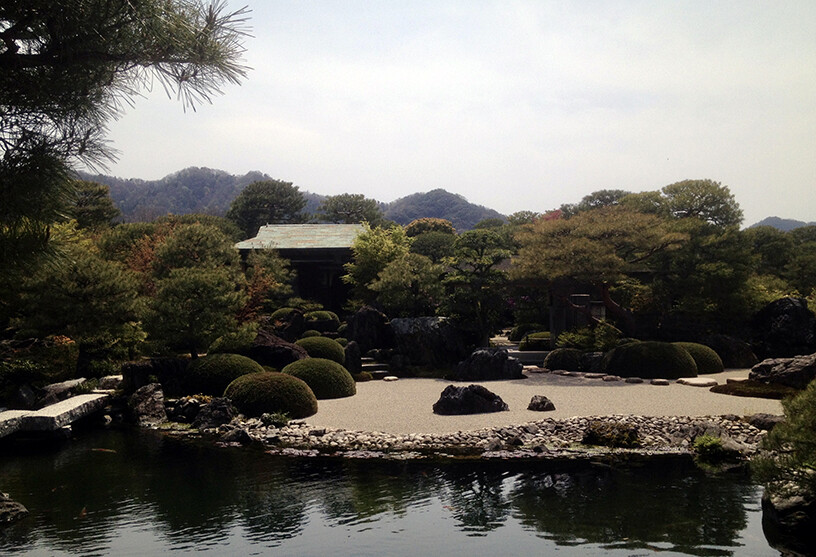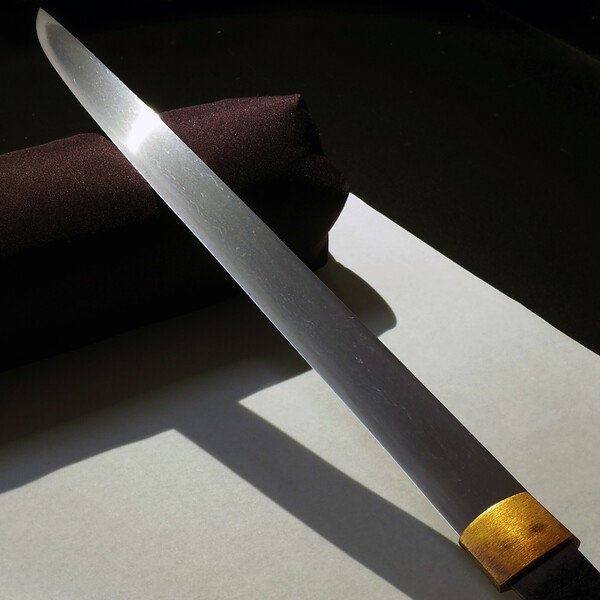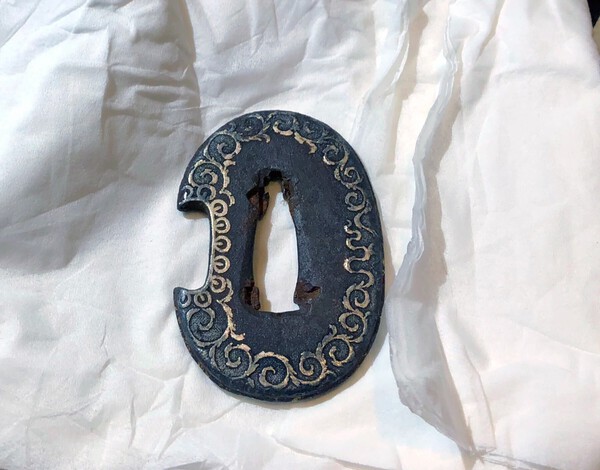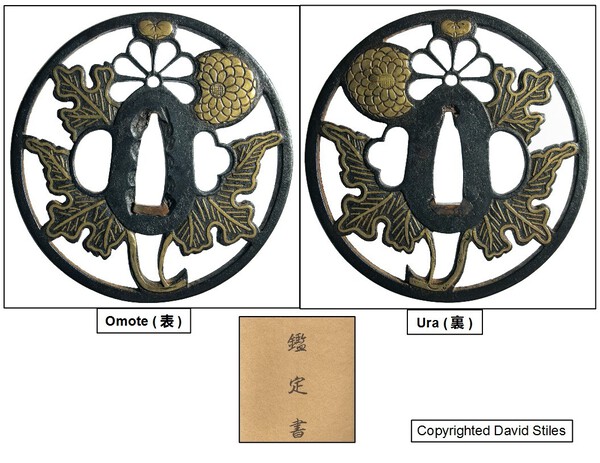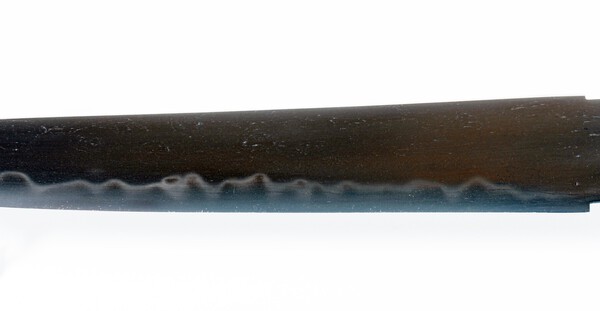-
Posts
2,904 -
Joined
-
Last visited
-
Days Won
3
Content Type
Profiles
Forums
Events
Store
Downloads
Gallery
Everything posted by Soshin
-
I never had a Ko-Uda work in my collection. I once had in my collection a mumei tanto with an attribution to "Den Uda Kunimune". The NTHK date the tantō production to the (Tenbun 天⽂) era of the late Muromachi Period (室町時代後期) circa 1532-1555 CE. Based upon the workmanship the maker of this tantō was likely the 4th generation Kunimune found in Japanese Swordsmith Revised by W. M. Hawley ID# KUN655.
-
Hi Colin T., The seppa-dai area would have been protected from moister when the tsuba was mounted on a sword. So, you would expect less corrosion of the iron around the area that contacted the seppa and then the tsuka on the omote side. That sounds like a good approach. Just some good rubbing with a plain cotton rag that is not hard, or abrasive is fine (sandpaper is unbelievably bad). I do that occasionally, with my old iron tsuba to lightly clean away the surface of any soft active red rust and maintain the patinated surface of harder black rust.
-
This sentence should read in my above quoted text: "I later submitted the tsuba to the NTHK-NPO at which time it was given a more formal attribution to Den Kyō-Shōami (傳京正阿弥), which I agreed with.".
-
@Tsuba gardener Neil, that might be a possibility. It is important to study good, signed examples to help establish the characteristics of the Goami Ryuha and how it systematically varied compared to some of the regional Shōami (正阿弥) Schools. My tsuba was unsigned and any type of attribution on an unsigned tsuba is much more difficult to perform. With all due respect, the original owner was just a little off with the Goami attribution in my opinion. @Spartancrest Dale, I don't think this is accurate information from the Christies auction house. The Goami School dates as early as the beginning of Edo Period and not the Muromachi Period of the 16th century.
-
Just as a relevant follow-up to this topic. I now have a tsuba! I picked up this tanto tsuba at this year's DTI. It fits nicely with the Shōki (Demon Queller) theme and the tanto's nakago in my opinion. I was able to talk to the professional craftsman (also attending DTI) that will be doing the mounting of the tanto and confirmed that I will be sending everything to him early next year. I will keep everyone updated as to the progress of this fun project.
- 13 replies
-
- 5
-

-
- tanto
- shin-shinto
-
(and 1 more)
Tagged with:
-
No not really, sorry. I remember the sukashi tsuba that I had with Goami attribution came from Skip Holbrook old collection with a Goami attribution made by the previous owner arrived at from his own personal research. I later submitted the tsuba to the NTHK-NPO at which time it was given a more formal attribution to Den Kyō-Shōami (傳京正阿弥), which I aggreged with. I later sold it back in 2015. Here is the tsuba for your reference and educational purposes only. I hope you find this additional information helpful.
-
The photo of the second post looks much better in terms of the real color of the surface. The iron bones in the one photo look nice. Looking at the tsuba from limited number of photos provided it does looks to be rust pitted a fair amount. The original polish nature of the plate as well as the overall thickness and lack of change in thickness of the plate between seppa-dai and mimi. This is called (niku 肉置) and is an important consideration for determining age. Taking all these features into consideration makes me think that it dates from approximately the early Edo Period. The specific shape of the kozuka hitsu-ana which I think is original to the tsuba also reminds me of the Early Edo production period. Nice tsuba thank you for sharing for discussion! P.S. @FlorianB Thank you for providing a link to Paul's website. I remember meeting him at DTI this year. I need to add his website to my collection of URLs.
-
It was so sad to hear of Gary's passing. I have two books by him on tsuba. I purchase both off eBay from him directly.
-
@Tsuba gardener Neil Bolden Yes, wide variety of designs and techniques used by this school (ryuha 流派) it was as varied as any of the regional (Shōami-ryuha 正阿弥流派) ex. (Kyōto-Shōami 京都正阿弥).
-
Here are some Arita-yaki cups and a small plate my wife picked up during our trip to Japan. I also really like them and just wanted to share. The Arita-yaki pottery kiln is in the city of Arita of Saga Prefecture located on Kyushu Island. Pottery has been procedued in the area of Saga for over 400 years. In the Edo Period it was Hizen Provience and Saga (佐賀) was the name of the castle town (jōkamachi 城下町). Feel free to discuss it politely and share any examples you might have.
-
- 1
-

-

Dai Token Ichi 2023
Soshin replied to Shogun8's topic in Sword Shows, Events, Community News and Legislation Issues
I attended and had a wonderful time! My wife enjoyed her visit to the show as well on Saturday afternoon. On Saturday focused on studying Japanese sword fittings (purchased a few) and on Sunday when it was less crowed, I focused on sword study. It was my first DTI and will not be my last. I would like to specifically thank Robert Hughes of Keichodo Fine Samurai Art for all the afterhours events before and during this year's DTI. -
I have received by papers at the end of October from Chris. The new owner of the menuki posted in the thread was incredibly happy to receive the papers from me a few days later. If you have not received yours by now it was part of the second group of papers written by the professional Japanese calligrapher done after this recovery from illness.
-

NEW(ISH) WEBSITE: OWAZAMONO.COM RE-LAUNCHED!!!!
Soshin replied to mdiddy's topic in Auctions and Online Sales or Sellers
Hi Matt J. I will add a link to your website on my website's Links webpage. Here is the Link's webpage of my website: LINKS (tsubaotaku.com). The link is at the bottom of the website. -

Reasons why swords cannot be imported in Belgium
Soshin replied to Yves's topic in General Nihonto Related Discussion
In the USA this is not an accurate statement. In Belgium it might be accurate, but I don't know as I have never been to Belgium. I have flown many times with antique Japanese edge weapons packed safely and securely packed in my checked bags placed in the cargo hold of the airplane without any problems. In terms of Japanese marital arts, I have mostly just participated in the local and semi-local demonstrations so flying was not necessary. -
Genuinely nice Japanese sword thank you so much for sharing your detailed write-up about it. One minor suggestion in the quoted text above. I have observed that in English writings about Japanese history, the Muromachi is referred to as a historical period and much shorter Oei as a historical era within the much larger historical period.
-

Art of Samurai Bonhams Online Auction
Soshin replied to Soshin's topic in Auctions and Online Sales or Sellers
Here is signed and papered Japanese sword and Koshirae being sold at this online auction to benefit of the New York Token Kai. Bonhams : MINO KUNIMUNE (ACTIVE LATE 16TH CENTURY) A Mino Wakizashi with Koshira-e Muromachi (1333-1573) or Momoyama (1573-1615) period, late 16th century -

Dai Token Ichi 2023
Soshin replied to Shogun8's topic in Sword Shows, Events, Community News and Legislation Issues
Here is a link to the PDF version of the 2023 DTI catalogue. The link was provided by Robert Hugues on his Facebook group. Look and enjoy. I am still in the process of looking through it in detail. My favorite \so far is the iron suakshi tsuba by Hayashi Matashichi (林又七) on page 95. toukenkumiai.com/wp/wp-content/uploads/daitoukenichi_h1-h4_231024.pdf?fbclid=IwAR0WWAAUjrRbAd-9GhKYkYhnoxj_5Cubzr9te_3DUhydYWEjF5TUwP_YiE4 -

Art of Samurai Bonhams Online Auction
Soshin replied to Soshin's topic in Auctions and Online Sales or Sellers
All these auction houses are for profit businesses driven by bottom line. I work in a business as a scientist. Its collective actions and my actions as a scientist are driven by the bottom line. -

Art of Samurai Bonhams Online Auction
Soshin replied to Soshin's topic in Auctions and Online Sales or Sellers
Thank you @Jussi Ekholm. This is an example of a thoughtful, informative, and importantly polite critique of some of the pieces up for sale at Art of Samurai Bonhams online auction. I was told on Sunday that one Japanese sword lot from this auction would help support the New York Token Kai. If I receive a follow-up confirmation email from the club officers which lot it is, I will post it here. -

Art of Samurai Bonhams Online Auction
Soshin replied to Soshin's topic in Auctions and Online Sales or Sellers
I agree this does look like a nice tanto from the photos. -
Like the tsuba I am sure the feel of the iron is nice in hand, but it isn't Owari. I would attribute this antique tsuba to being the work of the Shoami group circa the middle to late Edo Period especially with traces of what looks like gold inlay on the plate. Attached is a photo of an NBTHK papered Owari tsuba that I once owned as part of my collection. Notice how differently the openwork for the same design is done on my tsuba versus your tsuba. I hope this additional information is helpful to your study.
-
Just a quick community notice about the Art of the Samurai Bonhams Online Auction. Here is a link to register: Bonhams : Arts of the Samurai. I have already registered for this auction. Highlight of the auction include A Kotō Tachi made circa Kamakura period (1185-1333), 13th century attributed to Shinsoku with Shinsoku orikaeshi mei. The tachi is honzukuri, iorimune, ko-gissaki configuration with a strong koshizori curvature, forged in mokume hada with a ko-chōji tempered edge and midarekomi bōshi, ō-suriage tang with kiri file marks and four holes, orikaeshi mei Shinsoku, with a one-piece habaki, 26 1/2in (67.2cm.) long, in a wood shirasaya storage scabbard inscribed Matsudaira-ke zō (Matsudaira household collection). Here are some interesting provenance notes from the Bonhams website. Provenance Sold Christie's, New York, September 15, 2003, lot 384 Walter A. Compton Collection, sold Christie's, New York, Japanese Swords and Sword Fittings from the Collection of Walter A. Compton, Part II, October 22, 1992, lot 207 Tokugawa Ienari (1787-1837, purported) Matsudaira family (purported) Iwakura Tomomi (1825-1883, purported) The shirasaya bears an inscription claiming that in the early days of the Kamakura shogunate, in the second month of 1252, Prince Munetaka, son of the Emperor, went from Kyoto to Kamakura to inaugurate the government and was attended by Kiyohara Noritaka Sagami-no-suke Mikawa-no-kami, of the rank of Daiki Shōgo-i, to whom he gave this sword. With an origami (photocopy only) bearing the seal of the eleventh Shogun Tokugawa Ienari stating that the blade had been given to the Matsudaira family, and an origami (photocopy only), dated Meiji 9 (1876) and signed by the Iwakura household, stating that the blade had been given (to Prince Iwakura Tomomi) by the Matsudaira. Feel free to discuss it politely. Thank you.
-
Looking at the design aspects of the hitsu-ana of your tsuba, it has been mounted on a sword, and overall thickness of the plate I would say it is antique. It was likely made circa the middle to late Edo Period. I do see something on the surface of what looks like rust pitting of the surface that has since been aggressively cleaned much more recently. I would need to examine the tsuba in hand under good light to get a feel of the iron and confirm its age. Thank you for sharing I love your enthusiasm for old iron Japanese sword fittings.
-
I totally understand. I also started to regret after a while of having a Japanese art hobby business. I sold more Japanese swords and fittings then anything other types of Japanese art. For me at least it is best to have that clear separation. Business itself was poisoning the hobby for me in many respects. Some other people that are dealers are fine with it. I think it very much depends on the person.
-
All art is subjective by its true nature. Science is objective by its true nature. That is why I am a scientist and not an artist professionally. I only collect Japanese swords and fittings that fit my own subjective view of beauty.

